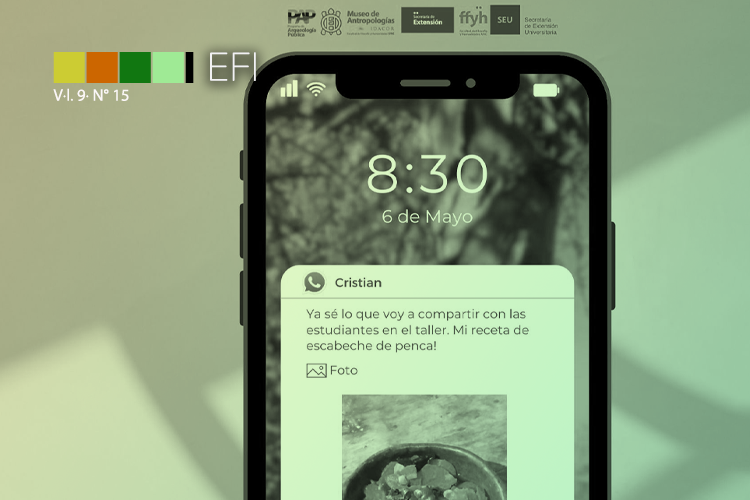The plants of our place
Dialogical construction of school materials for the initial and primary school levels about native plants
Keywords:
native plants, ecology of knowledge, ISFD, museum, indigenous peopleAbstract
But… what are native plants? Thus we were questioned by teachers of Natural Sciences of the Higher Institute of Teacher Training (ISFD) Adoratrices. They asked for a universal and academic definition of native plants, arguing that their students felt dizzy in front of the information and the diverse ways of classifying it.
We developed the extension project “Cultural diversity, native plants and heritage: multivocal educational proposals for the initial and primary levels” (2020 and 2021) with teachers and students of the ISFD, workers of the Historical Museum of Villa del Rosario (Province of Córdoba), neighbours from the department of Río Segundo, members of the Autonomous Provincial Indigenous Educational Council, the Provincial Indigenous Council and the Public Archaeology Program (Museum of Anthropology, SEU-FFyH and IDACOR). We carried out workshops on native plants, we collected local knowledge and classified it based on definitions given by neighbours and texts made by academics to create teaching materials.
We want to socialize the mutual learning fostered by the reflexivity of teachers, students and anthropologists, analysing how we negotiated definitions and meanings to seek an ecology of knowledge (Boaventura de Sousa Santos, 2018) betting on classifications of native plants that did not repeat those of manuals of botany or pharmacopoeias, but would incorporate new voices and knowledge to the educational system. This is how we created the didactic material “The plants of our place: multivocal educational proposals for the initial and primary levels” that compiles didactic sequences authored by ISFD students and teachers (Muñoz Paganoni et al., 2020).
References
Bourdieu, P. (2008). El oficio de sociólogo. Siglo XXI.
Campos, C. M. (2012). Los niños y la biodiversidad. ¿Qué especies conocen y cuáles son las fuentes de conocimiento sobre la biodiversidad que utilizan los estudiantes? Un aporte para definir estrategias educativas. Boletín Biológica, 4, 4-9.
Descola, P. (2010). Diversité des Natures, Diversité des Cultures. Bayard. (Traducción de B. Marconetto).
Descola, P. (2016). La diversidad de las naturalezas. La composición de los mundos (pp. 141-198). Capital intelectual.
Guber, R. (2016). La observación participante; La entrevista etnográfica, o el arte de la “no directividad”; El registro: medios técnicos e información sobre el proceso de campo. La Etnografía. Método, campo y reflexividad (pp. 51-109). Siglo XXI.
Mapa colaborativo del proyecto “Diversidad cultural, plantas nativas y patrimonio: propuestas educativas multivocales para los niveles inicial y primario”. https://maphub.net/alfoskywalker/proyecto-plantas-nativas-y-diversidad-cultural
Martínez, G. J. (2010). Las plantas en la medicina tradicional de las Sierras de Córdoba. Ediciones del Copista.
Mato, D. (2018). Repensar y transformar las universidades desde su articulación y compromiso con las sociedades de las que forma parte. Revista +E 8(9), 38-52.
Muñoz Paganoni, A., Zabala, M. E. y Fabra, M. (2021). Blog del proyecto “Diversidad cultural, plantas nativas y patrimonio: propuestas educativas multivocales para los niveles inicial y primario”. https://blogs.ffyh.unc.edu.ar/diversidad-plantasnativas-patrimonio/
Muñoz Paganoni, A., Zabala, M. E. y Fabra, M. (2022). Las plantas de nuestro lugar. Propuestas educativas multivocales para el nivel inicial y primario. Museo de Antropología – IDACOR. Disponible en: https://suquia.ffyh.unc.edu.ar/handle/suquia/18470
Santos, B. (2018). Justicia entre saberes: epistemologías del Sur contra el epistemicidio. Ediciones Morata.
Segato, R. L. (2013). La crítica de la colonialidad en ocho ensayos. Y una antropología por demanda. Prometeo libros.
Viveiros de Castro, E. (2013). La Mirada del Jaguar. Introducción al Perspectivismo Amerindio. Tinta Limón.

Downloads
Published
Issue
Section
License

This work is licensed under a Creative Commons Attribution-NonCommercial-ShareAlike 4.0 International License.
Atribución No Comercial Compartir Igual (by-nc-sa):
No se permitirá un uso comercial de la obra original, ni de las posibles obras derivadas, la distribución de las cuales se debe hacer con una licencia igual a la que regula la obra original.






